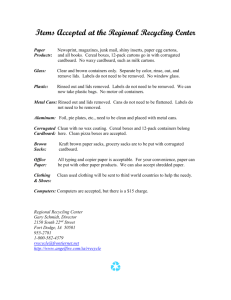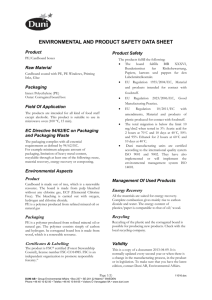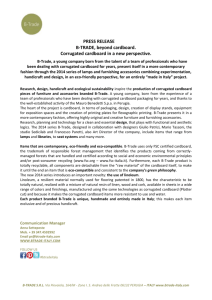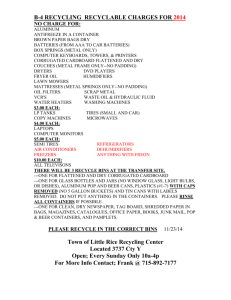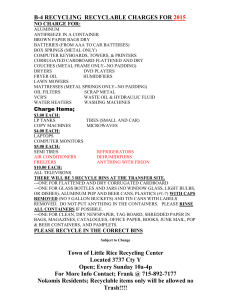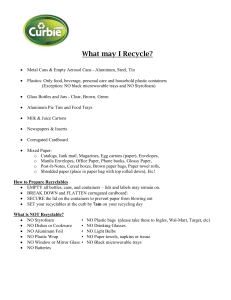corrugated cardboard
advertisement
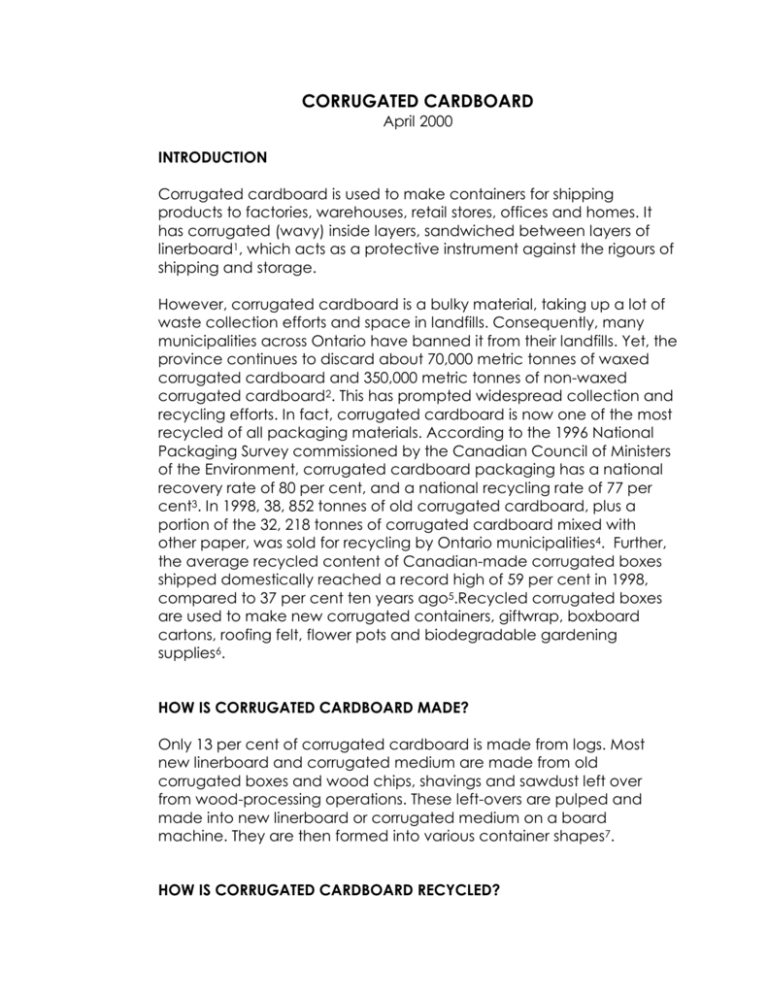
CORRUGATED CARDBOARD April 2000 INTRODUCTION Corrugated cardboard is used to make containers for shipping products to factories, warehouses, retail stores, offices and homes. It has corrugated (wavy) inside layers, sandwiched between layers of linerboard1, which acts as a protective instrument against the rigours of shipping and storage. However, corrugated cardboard is a bulky material, taking up a lot of waste collection efforts and space in landfills. Consequently, many municipalities across Ontario have banned it from their landfills. Yet, the province continues to discard about 70,000 metric tonnes of waxed corrugated cardboard and 350,000 metric tonnes of non-waxed corrugated cardboard2. This has prompted widespread collection and recycling efforts. In fact, corrugated cardboard is now one of the most recycled of all packaging materials. According to the 1996 National Packaging Survey commissioned by the Canadian Council of Ministers of the Environment, corrugated cardboard packaging has a national recovery rate of 80 per cent, and a national recycling rate of 77 per cent3. In 1998, 38, 852 tonnes of old corrugated cardboard, plus a portion of the 32, 218 tonnes of corrugated cardboard mixed with other paper, was sold for recycling by Ontario municipalities4. Further, the average recycled content of Canadian-made corrugated boxes shipped domestically reached a record high of 59 per cent in 1998, compared to 37 per cent ten years ago5.Recycled corrugated boxes are used to make new corrugated containers, giftwrap, boxboard cartons, roofing felt, flower pots and biodegradable gardening supplies6. HOW IS CORRUGATED CARDBOARD MADE? Only 13 per cent of corrugated cardboard is made from logs. Most new linerboard and corrugated medium are made from old corrugated boxes and wood chips, shavings and sawdust left over from wood-processing operations. These left-overs are pulped and made into new linerboard or corrugated medium on a board machine. They are then formed into various container shapes7. HOW IS CORRUGATED CARDBOARD RECYCLED? The separation of contaminants from the cardboard is a crucial first step in the recycling process to keep machinery working properly and to achieve good quality paper. After this is completed, corrugated boxes are dumped into a pulper where moisture is added to create a ‘slush’. The ‘slush’ is then pumped through small holes at the bottom of the pulper and passed through spinning cleaners to remove staples, broken glass and plastics. The fibres are broken down, and water is drained from the ‘slush’ to produce a smooth ‘stock’. Waxes, adhesives, fine plastic particles, grit and glass are removed from the stock by passing it through pressure screens. The final screened stock is pressed to remove water and then dried8. Roughly 68 per cent of old corrugated cardboard is used to make new corrugated containers. However, it is also used for the production of other goods such as: kraft paper used by manufacturers for bags and wrap tubes and core board used by manufacturers for tissue towelling, giftwrap, and textiles boxboard containers gypsum wallboard liner and roofing felt used in home renovation and building packaging materials used for shipping and sale of breakable objects such as fluorescent light bulbs and china flower pots and biodegradable gardening supplies used by greenhouses and garden outlets9 REDUCING, REUSING, AND RECYCLING EFFORTS Many companies are emphasizing the reduction, reuse, and recycling of corrugated containers. For example, Cobblestone packaging that buys custom corrugated containers from businesses, now also accepts used and overrun containers, often termed ‘old corrugated cardboard’ (OCC). The company buys them for about a penny each and sells them at the going rate which fluctuates with supply and demand. Cobblestone sells to 650 companies, most of whom are not concerned with any writings or markings on the packaging. One customer, Canadian Tire, uses overrun boxes for inter-house shipping10. There are also four mills in Ontario that use OCC in their manufacturing. These are the Domtar mills in Trenton and Mississauga, the Atlantic Packaging mill in Scarborough, and Paperboard Industries in Toronto. Paperboard Industries have two mill, one in Toronto and the other in Vancouver. The Toronto plant purchases 1, 500 tonnes of OCC per month, as well as other grades of paper. The wastepaper is used in the manufacture of linerboard (the liner of the corrugated container) and boxboard11. In addition, some municipalities such as Guelph and the Township of North Dorchester collect corrugated cardboard from schools. In some places there are also depots set up for corrugated cardboard, alone or in combination with other materials. For example, the Wellington County Recycling Program, which involves 21 municipalities, has a depot for OCC, used mainly by the industrial, commercial and institutional sectors. OCC recovery and consumption are based largely on economic factors. Increased demand for containerboard, high costs for virgin fibres, the export market, and mill expansion will all help to increase the demand for OCC. Such an increase will also result from the escalating disposal fees and landfill bans on corrugated cardboard12. ENDNOTES 1 Resource Integration System Calvin Chong and Bob Hamersma, Growing Plants with Recycled Cardboard (Journal of Composting and Recycling BioCycle), March 1995, p.86-7. 3 Paper and Paperboard Packaging Environmental Council, “About Corrugated Boxes” <http://www.ppecpaper.com/zip/corrugated.htm> 4 Municipal 3Rs 1998 Factsheet, 3Rs Information Partnership 5 Refer to Reference 3 6 Refer to Reference 1 7 Refer to Reference 3 8 Norampak Mississauga Linerboard Mill Factsheet 9 Refer to Reference 1 10 Bob Yudin, Cobblestone Packaging 11 Paperboard Industries, (416) 461-8261 12 Refer to Reference 1 2
